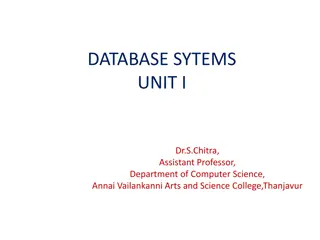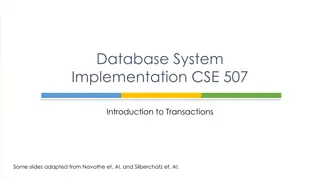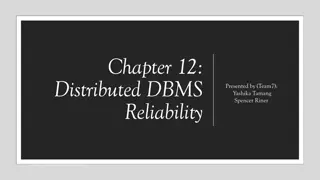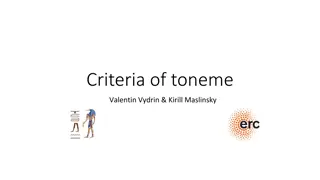Understanding Atomicity Violation in Concurrent Programs
Explore the concept of atomicity violation in concurrent programs along with detection techniques to ensure the integrity of critical code blocks. Learn from examples and insights shared by Prof. Moonzoo Kim.
0 views • 23 slides
Understanding Database Systems in IT
Database systems play a crucial role in managing and organizing data efficiently. They provide a structured environment for storing and accessing information, enabling various applications in sectors like banking, airlines, universities, sales, and more. The transition from traditional file systems
3 views • 38 slides
Understanding Properties of Database Transactions
Database transactions play a crucial role in ensuring data integrity and consistency within a database system. This content explores the fundamental properties of transactions, such as atomicity, durability, consistency, and isolation. It delves into the requirements and implications of each propert
2 views • 44 slides
Distributed DBMS Reliability Overview
This chapter delves into the critical aspect of reliability in distributed database management systems (DBMS). It explores the concepts, measures, types of faults, and the significance of maintaining atomicity and durability properties of transactions in ensuring system reliability. The narrative hi
0 views • 51 slides
Real-World Concurrency Bugs and Detection Strategies
Explore the complexities of real-world concurrency bugs through a study of 105 bugs from major open-source programs. Learn about bug patterns, manifestation conditions, diagnosing strategies, and fixing methods to improve bug detection and avoidance. Gain insights from methodologies evaluating appli
0 views • 20 slides
A Deep Dive into the Pony Programming Language's Concurrency Model
The Pony programming language is designed for high-performance concurrent programming, boasting speed, ease of learning and use, data race prevention, and atomicity. It outperforms heavily optimized MPI versions in benchmarks related to random memory updates and actor creation. With an API adopted f
0 views • 33 slides
Understanding Durability of Transactions and Crash Recovery
Exploring the concepts of ACID properties, system crashes, motivation behind atomicity and durability, concurrency control assumptions, memory organization, buffer pool management, and considerations for enforcing atomicity and durability in transaction processing systems.
0 views • 29 slides
Understanding Database Transactions and Concurrency Control
This content delves into the world of database transactions, exploring concepts such as ACID properties, locking schedulers, anomalies in scheduling, and implementing transaction control mechanisms like Two Phase Locking. It covers the importance of maintaining atomicity, consistency, isolation, and
0 views • 36 slides
Hybrid Tracking of Cross-Thread Dependences in Parallel Programs
Dynamic analysis techniques are explored in this research for error detection and performance enhancement in parallel programs. The study combines pessimistic and optimistic tracking of cross-thread dependences to address issues like data race detection and atomicity violation. The proposed hybrid t
0 views • 68 slides
Principles and Criteria of Toneme in Linguistics
Toneme, recognized as a key element in tonology, is defined as a meaningful tone that can differentiate lexical or grammatical meanings. The principles and criteria surrounding toneme status are systematically explored and proposed, emphasizing properties like sequentiality, continuity, scalability,
0 views • 27 slides
Understanding Relational Database Design Principles
Explore the features of good relational design, including atomic domains and first normal form decomposition. Learn about functional dependency theory, algorithms, and database design processes. Discover the importance of atomicity in domain design and the implications of non-atomic values. Gain ins
1 views • 71 slides









